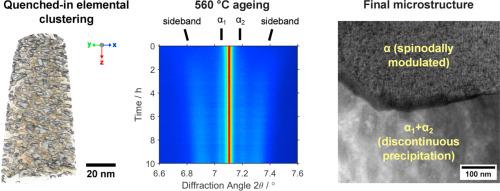Spinodal decomposition and discontinuous precipitation in a low‑solvus Au‑Pt‑Pd alloy: an in situ X‑ray diffraction study
IF 9.3
1区 材料科学
Q1 MATERIALS SCIENCE, MULTIDISCIPLINARY
引用次数: 0
Abstract
Spinodal decomposition and discontinuous precipitation are critical phase transformations that influence the mechanical properties of Au‑Pt‑based alloys. In this study, the microstructural evolution of a developmental Au-Pt-Pd alloy during ageing has been characterised in situ using high-resolution synchrotron X-ray diffraction. This alloy was designed to have a low solvus temperature, while retaining significant age‑hardenability. For the ageing temperatures studied (560 °C, 653 °C, and 741 °C), sideband peaks developed at the leading and trailing edges of the fundamental Bragg reflections, which are characteristic of a modulated structure formed by spinodal decomposition. With further ageing, the sidebands and parent Bragg reflections were progressively replaced by peaks from two face-centred cubic phases with different lattice parameters. Examination of the aged microstructure by electron microscopy revealed that these phases formed co‑operatively at grain boundaries by discontinuous precipitation and consumed the pre-existing modulated structure. The temporal evolution of the diffraction data indicated that the modulated structure underwent power‑law coarsening while the kinetics of discontinuous precipitation were well described by the Avrami model for nucleation and growth. Additionally, anisotropic and asymmetric broadening of diffraction peaks observed in the as‑quenched condition was attributed to coherency strains arising from elemental clustering, as detected by atom probe tomography. These findings demonstrate the utility of high-resolution synchrotron X-ray diffraction for gaining previously inaccessible insights into the precipitation phenomena that relate composition, microstructure, and crystallography in phase-separating systems.


低溶剂Au - Pt - Pd合金中的Spinodal分解和不连续沉淀:原位X射线衍射研究
Spinodal分解和不连续析出是影响Au - Pt基合金力学性能的关键相变。在这项研究中,利用高分辨率同步x射线衍射原位表征了一种发育中的Au-Pt-Pd合金在时效过程中的显微组织演变。该合金具有较低的溶剂温度,同时保持显著的时效淬透性。对于研究的老化温度(560°C, 653°C和741°C),在基本布拉格反射的前后边缘出现边带峰,这是由spinodal分解形成的调制结构的特征。随着进一步老化,边带和母布拉格反射逐渐被两个具有不同晶格参数的面心立方相的峰所取代。通过电子显微镜观察时效组织发现,这些相通过不连续析出在晶界处共同形成,并消耗了预先存在的调制结构。衍射数据的时间演化表明,调制结构经历幂律粗化,而不连续沉淀的动力学可以用Avrami模型很好地描述成核和生长。此外,原子探针断层扫描检测到,在淬火条件下观察到的衍射峰的各向异性和不对称展宽归因于元素聚类引起的相干应变。这些发现证明了高分辨率同步加速器x射线衍射在获得与相分离系统中的成分、微观结构和晶体学相关的沉淀现象方面的实用性。
本文章由计算机程序翻译,如有差异,请以英文原文为准。
求助全文
约1分钟内获得全文
求助全文
来源期刊

Acta Materialia
工程技术-材料科学:综合
CiteScore
16.10
自引率
8.50%
发文量
801
审稿时长
53 days
期刊介绍:
Acta Materialia serves as a platform for publishing full-length, original papers and commissioned overviews that contribute to a profound understanding of the correlation between the processing, structure, and properties of inorganic materials. The journal seeks papers with high impact potential or those that significantly propel the field forward. The scope includes the atomic and molecular arrangements, chemical and electronic structures, and microstructure of materials, focusing on their mechanical or functional behavior across all length scales, including nanostructures.
 求助内容:
求助内容: 应助结果提醒方式:
应助结果提醒方式:


